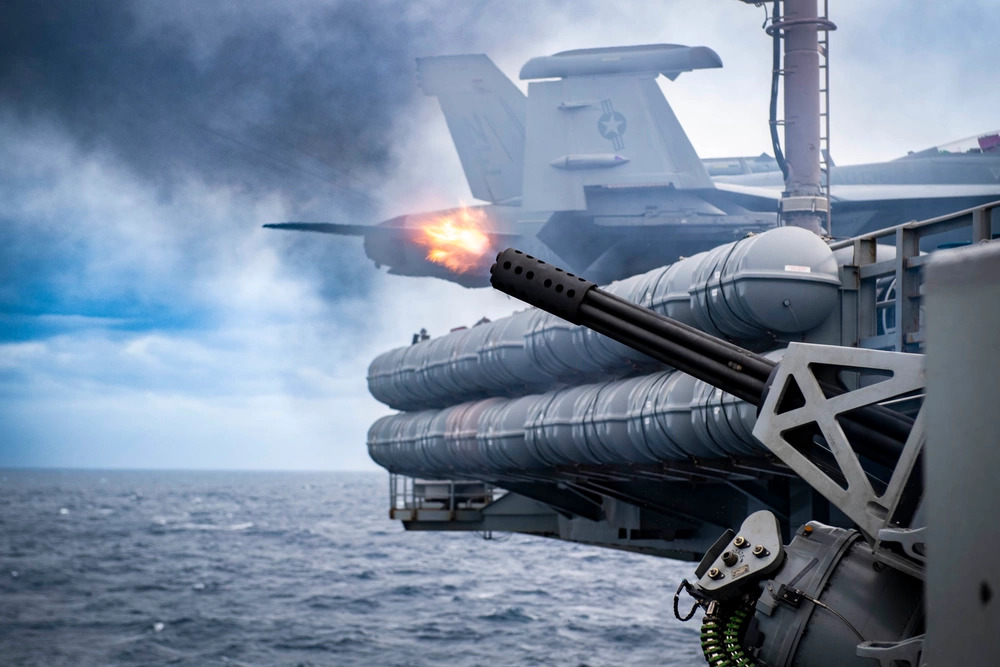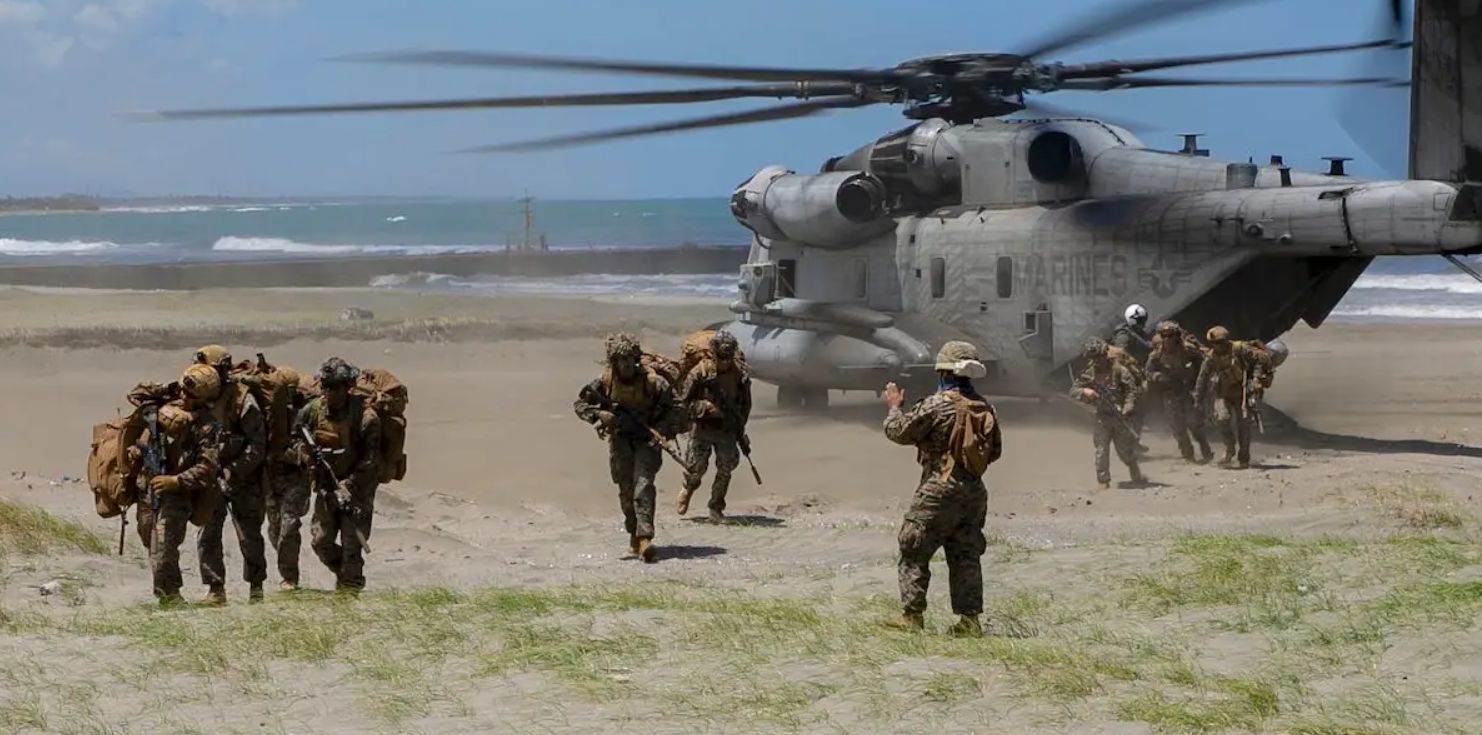An incensed China has targeted the US for deploying its Navy’s USS Carl Vinson carrier strike group (CSG) in the South China Sea. Chinese Communist Party’s mouthpiece, Global Times, fired verbal shots at the US from the shoulders of two Chinese maritime analysts, claiming the US Navy was no match for the anti-carrier warfare capabilities of the People’s Liberation Army.
“Poorest” Air Force With ‘Most Powerful’ Fighters: Troubled IAF Plans To Fly F-15EX, Rafale, F-16, Su-30MK2, F-16 & KF-21
The Chinese experts quoted by Global Times claimed Beijing commanded military superiority in the western Pacific, where American carriers are vulnerable to long-range missile strikes.
The experts, as expected, slammed the US for the provocative move (CSG deployment) in the South China Sea and claimed that it was aimed at stoking tensions with the Philippines. Vietnam, Malaysia, Taiwan, Japan, and the Philippines have contested China’s territorial claims in the South and East China seas.
Chinese and Philippine coast guards have challenged each other over Manila resupplying its naval unit at Ren’ai Jiao (also known as Ren’ai Reef) by sending materials to reinforce an old warship that ran aground there years ago.
Tensions in the western Pacific have been unprecedentedly high, with all three flashpoints of the Korean Peninsula, the Taiwan Straits, and the SCS being active with confrontations between the US-Japan-Taiwan-South Korea camp and the opposing China-Russia-North Korea grouping.
US Carrier Strike Group In The South China Sea
According to the US’s Indo-Pacific Command (INDOPACOM), the USS Carl Vinson CSG is “currently operating” in the SCS following a successful port visit to Singapore.
The flotilla conducted “maritime security operations,” including “flight operations with fixed and rotary wing aircraft, maritime strike exercises, and coordinated tactical training between surface and air units.” The CSG’s presence in the SCS and the subsequent exercises are “part of the US Navy’s routine presence in the Indo-Pacific.”
Besides the carrier, the CSG consists of five guided missile cruisers and destroyers, including the Ticonderoga-class USS Princeton, Arleigh Burke-class destroyers USS Hopper, USS Kidd, USS Sterett, and USS William P. Lawrence.
Before entering the South China Sea, the CSG participated in a trilateral maritime exercise with the Japan Maritime Self-Defense Force (JMSDF) and the Republic of Korea Navy to “conduct enhanced planning and advanced maritime communication operations.” Pictures released by the USN also showed the USS Carl Vinson firing an MK 15 Phalanx Gatling-gun close-in weapons system (CIWS).

China Infuriated By US Navy Deployment
While China strongly reacted to the American fleet’s presence, its experts downplayed the naval maneuvers, saying they served a more “symbolic” and “political” goal rather than a concerted military intent.
A Global Times report quoted Chen Xiangmiao, director of the World Navy Research Center at the National Institute for South China Sea Studies, who said, “US aircraft carrier activity in the South China Sea is nothing new. Such moves usually attempt to deter China and show support to US allies so that the US can consolidate its hegemony.”
He said while US carriers “still operate” in the SCS, they tend “not to stay” for “too long” because the US Navy “understands” the Chinese military’s “capabilities in targeting large moving warships on its doorstep.”
This “significantly reduces” the “survivability” of aircraft carriers, he said, adding that “thus, USN carriers in the SCS serve more as “political and diplomatic tools” than “actual military instruments.”
Meanwhile, China’s Ministry of Foreign Affairs slammed the Philippines for “provoking” the conflict by trying to control the disputed area and changing the status quo. MFA spokesperson Mao Ning said the face-off between the coast guard vessels was caused by the Philippines’ “change of policy and position” and “violating” the Declaration on the Conduct of Parties in the South China Sea.
“We hope that the Philippines returns to dialogue and consultation and work with China to handle and manage the situation at sea properly.” This statement came a day before the Global Times article on the Carl Vinson CSG deployment. The MFA spokesperson did not mention the US in her reply to a question on the Philippines maritime dispute.
Previous US Assessments Talk Of Naval Weakness In Western Pacific
The US Navy’s former Indo-Pacific Command Chief (INDOPACOM), Admiral Harry Harris, told the Senate Armed Services Committee in 2018 that American vessels were at a “disadvantage (before) China (with its) ground-based ballistic missile that threatens our basing in the western Pacific.”
His successor, Admiral Phil Davidson, concurred three years later in 2021 while discussing China’s missile tests. “These mid-range, anti-ship ballistic missiles are capable of attacking aircraft carriers in the western Pacific,” Davidson said about the DF-21D. The missile is highly unorthodox anti-ship ballistic missile (ASBM) with ranges above 2,000 kilometers. Designed specifically against American carrier strike groups, the missile follows a ballistic path and then re-enters the atmosphere, releasing warheads at possibly hypersonic speeds at American warships.
Former US Marine Corps Officer Robert Haddick, who was then a Visiting Senior Fellow at the Mitchell Institute for Aerospace Studies, told Reuters in 2019 that it is a “huge gap,” adding, “China’s anti-ship missile capability exceeds those of the United States in terms of range, speed, and sensor performance.”

If weapon performance is insufficient, logistics to sustain a long-drawn conflict is another handicap. The US Marine Corps Assistant Commandant, General Eric Smith, called this capability gap a “dirty little secret” in a Stimson Centre webinar reported by EurAsian Times in 2022.
The US’ logistics are fledgling, and it has no means to sustain a lengthy conflict while China can. “We cannot rely on big, heavy platforms to be loaded on a strategic lift on 30 days’ notice while we shuffle our way into support. Force Design 2030 makes the problem less since it relies on lighter, mobile, smaller forces,” Smith said then.
While a wargame in 2020 conducted by the think tank RAND Corporation repeatedly ended in devastating US and Taiwanese defeats, another wargame by the Center for Strategic and International Studies (CSIS) in 2022 resulted in the US-Taiwan victory, as Chinese amphibious warfare capabilities were found to be lacking compared to the American capabilities to counter the invasion.
Independent US-based defense analyst Ben Lewis acknowledges Chinese missile capabilities and, at the same time, doesn’t write off the American military in the western Pacific. The DF-21D is something the US military “definitely takes seriously,” and the “defensive capabilities” of the American CSGs are also as credible as the Chinese missile, he told EurAsian Times.
“We have the world’s most sophisticated layered air defense protecting our carriers. We have a lot of logistical challenges, but we are making strides in setting ourselves up for easier sustainment of forces in the region.
“While it provides some challenges, I don’t think it eliminates our significant qualitative advantages over the PLA. We have been doing power projection for a very long time, and this experience (combined with the quality of our systems) gives us a serious advantage,” Lewis said.
Internal Debate Within US Marine Corps
The latest warning has come from former US Marine Corps Generals and commandants, who have been opposing the service’s previous chief, General David Berger’s Force Design 2030 doctrine for the last two years.
The operational concept envisages small teams of lightly-armed, missile-firing, and island-hopping Marine units undertaking anti-ship missilery on Chinese vessels from friendly allied-controlled features in the South and East China Seas.
Quoting from a report in the Wall Street Journal (WSJ), the Daily Caller said how former USMC Commandants like Generals Joe Dunford, Anthony Zinni, and Charles Kurlak had been trying to impress upon Berger to reconsider his plan, which was “flaying the fabric” of the service.
It quoted retired Lt. Col. Scott Moore, who said the wargames were built on some “unchallenged assumptions” about Marines being able to station themselves on remote islands in the Pacific “with an adequate logistics trail before Chinese forces contested the area.”
- The author can be reached at satamp@gmail.com
- Follow EurAsian Times on Google News




